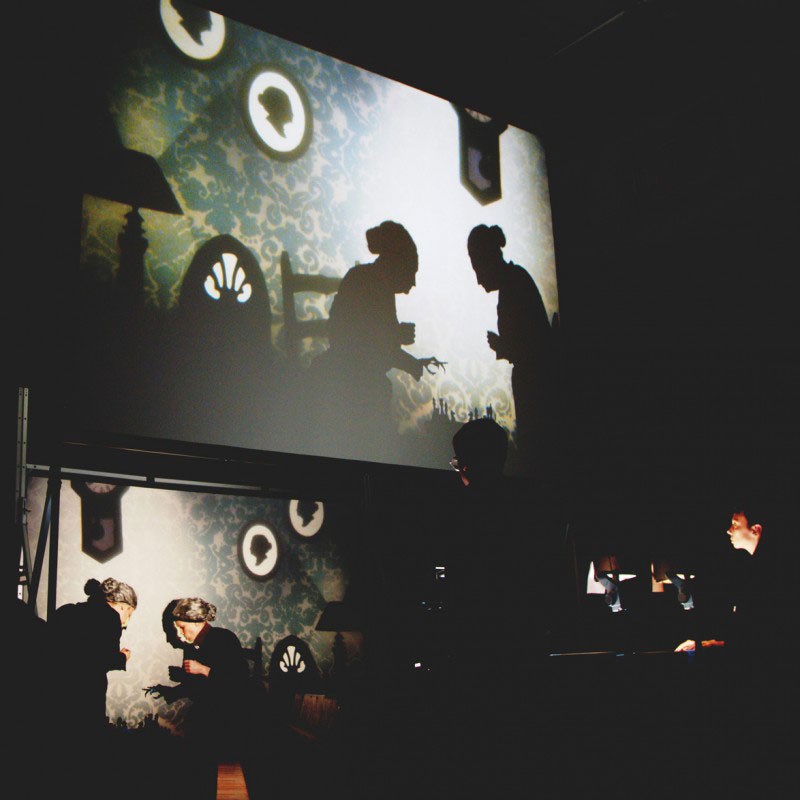If you still think shadow puppetry consists solely of nimble fingers and paper figures on Popsicle sticks, it’s time to let your imagination grow up.
At the hands of companies like Chicago-based puppetry wizards Manual Cinema, the art form has fully matured to encompass complex, feature-length storytelling, live music and technically sophisticated cinematic elements such as live actors and surround sound. In fact, those are the building blocks of a critically acclaimed Manual Cinema show, making it’s one-night-only debut in Vancouver on Feb. 7 as part of the Chan Centre’s Beyond Words storytelling series.
Entitled Ada/Ava, the show follows two septuagenarian twins through melancholy New England in a haunting, gothic journey of grief, death and family ties.
Hailed as an “unclassifiable story of spectral beauty” by the New York Times, and with more than 20 such shows under their belts, we caught up with co-artistic director Drew Dir to discuss the making of two-dimensional magic.
In your experience, what do adults react to? What kind of things really work on a more mature audience?
It’s been a process of us learning what’s interesting about this work and how people view it, because we’ve been learning about the medium at the same time as our audience. In general, because we’re making shows that don’t have any dialogue or narration or text – they’re told purely through image and music – already we’re dealing with a set of restrictions on the kind of story we can tell. So, often times we chose very simple stories, like, one or two characters just following their journey. But through that simple story, we try to make the way we tell it super complex and super cinematic.
I think what people are drawn to in our work is that, like, everyone grows up watching cinema and watching films, and everyone is really fluent in cinematic language. To see that cinematic language recreated in a very analogue, handmade, manual way is, I think, really gratifying to people. Because they’re recognizing something familiar, but it’s presented to them in a totally strange, new context.
What is the back bone of a good puppet story? Even for a simple one- or two-character journey like this?
They need to be stories that read well in shadow. To take Ada/Ava, as an example – that show started with the idea of telling a story about a set of twin sisters, because we realized that if you put two actors behind a screen and you make them look identical – like, read them as twins – already, before you put any dialogue or text on it, you’re telling a story. There’s already a little hint of character or story there.
So, we think of it in terms of: there’s some things the medium does well, and some things the medium doesn’t do well. If you can land on a story where it feels like the medium is working with you, then 50 per cent of the job is already taken care of.
In what ways does shadow puppetry work against you? Depth? Facial expression?
A lot of it is that; because there’s so little information, the audience loses access to the face, they lose access to text and words. We want to tell the audience how this character is feeling and on paper, when we plot it out, it looks great and the story is super compelling, but when we stage it in the medium you can discover that the story isn’t coming across at all, or not clearly enough.
We experience that almost every day when we’re staging our stuff. A lot of the rehearsal process is us failing at telling a story and us listening to the medium, telling us what kind of story it wants to say.
Is using people – actors – with wigs and prosthetics on their face a form of ‘cheating’ in the puppetry world?
[Laughs] I worry about that all the time. I think it gets to something about our work which is that it’s not pure puppetry. I feel conscious of that when we’re around puppetry people. We’re using a lot of different tools in our work because it is multidisciplinary. A large part of it clearly is puppetry, at the same time we’re also using a cinematic language to tell a story, which is really more film than it is puppetry, and we’re also using music to tell a lot of the story. There are a lot of different vectors of storytelling that are coming together, and only one of those vectors is puppetry.
Manual Cinema’s Ada/Ava will be in Vancouver for one night only, Feb. 7.


